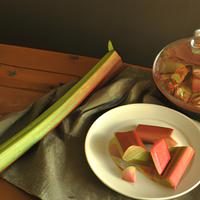
1 serving (100 grams) contains 29 calories, 0.4 grams of protein, 0.2 grams of fat, and 7.0 grams of carbohydrates.

Log this food in SnapCalorie

Nutrition Information
Calories |
69.0 | ||
|---|---|---|---|
% Daily Value* |
|||
| Total Fat | 0.4 g | 0% | |
| Saturated Fat | 0.1 g | 0% | |
| Polyunsaturated Fat | 0 g | ||
| Cholesterol | 0 mg | 0% | |
| Sodium | 9.5 mg | 0% | |
| Total Carbohydrates | 16.8 g | 6% | |
| Dietary Fiber | 5 g | 17% | |
| Sugars | 14.4 g | ||
| protein | 1.0 g | 2% | |
| Vitamin D | 0 mcg | 0% | |
| Calcium | 204.8 mg | 15% | |
| Iron | 0.5 mg | 2% | |
| Potassium | 352.4 mg | 7% | |
* Percent Daily Values are based on a 2,000 calorie diet. Your daily values may be higher or lower depending on your calorie needs.
Food Attributes
Source of Calories
About Cooked rhubarb
Cooked rhubarb is a versatile ingredient celebrated in both sweet and savory dishes, particularly in European and North American cuisines. With origins tracing back to ancient China and Siberia, rhubarb has historically been used for both culinary and medicinal purposes. Once cooked, its naturally tart flavor mellows and pairs well with sugar, spices, or fruit. Nutrition-wise, rhubarb is low in calories and high in fiber, making it a good choice for digestion support. It’s also a source of vitamin K, calcium, and antioxidants, which contribute to bone health and combat oxidative stress. However, it’s typically sweetened heavily in recipes, which adds sugar content to the final dish. Additionally, the leaves contain oxalic acid and are toxic, but the edible stalks are safe when properly prepared. Cooked rhubarb offers a unique flavor profile and mild health benefits, especially when enjoyed in moderation as part of a balanced diet.



